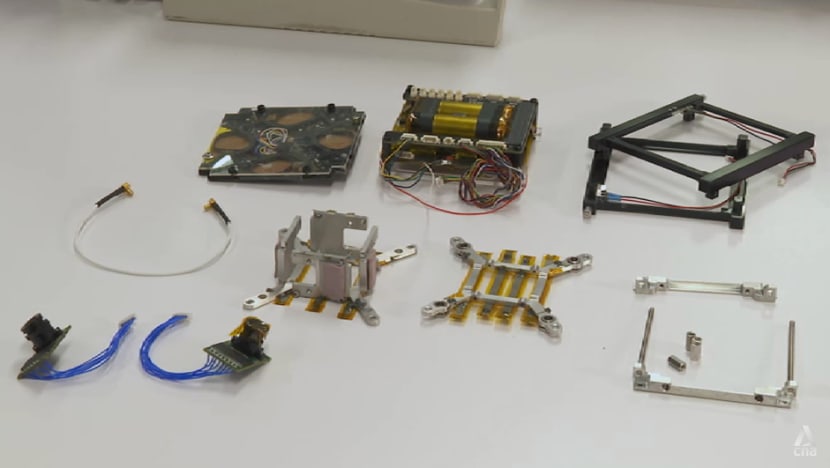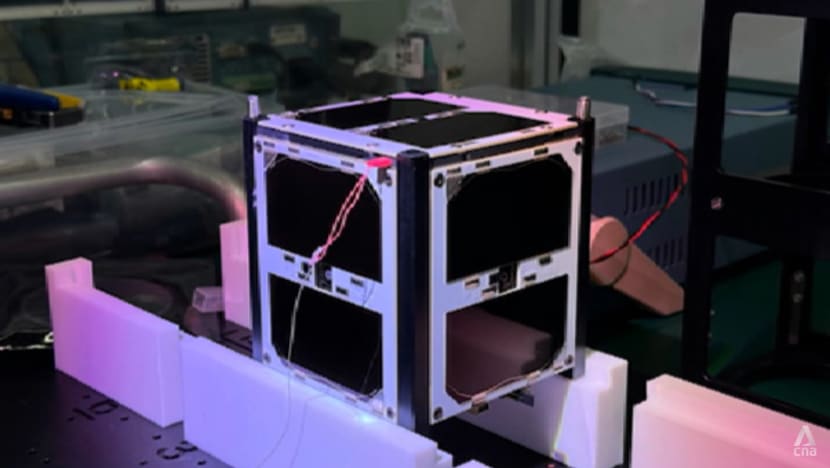NUS High School students build nanosatellite, eye space launch next March
SINGAPORE: For the first time, students from a Singapore high school have built a nanosatellite that will be launched into space.
The nanosatellite will be loaded onto a SpaceX rocket and will launch from Florida in the United States in March next year.
Its task will be to take pictures of the Earth from space.
The team from the NUS High School of Mathematics and Science said the project is the first step of a more ambitious goal to build bigger satellites.
Students involved in the endeavour are from the school’s Galileo programme specialising in space engineering.
The programme, taken on top of regular curriculum, exposes students to issues typically faced by engineers in the designing and building of systems deployed into space.
BUILDING THE NANOSATELLITE
The foundation for the satellite started with a circuit board five years ago.
Former NUS High student Lin Yicheng was just 16 when he got involved in the programme in 2020.
Even after graduation, the alumnus returned to school every year to aid his juniors with the space project.
He helped customise the satellite's image compressor by studying documents from the National Aeronautics and Space Administration (NASA) in the US and reverse-engineering similar software.
“This algorithm is actually used on (NASA’s) Mars rovers. It's meant for seriously long-distance stuff,” said Mr Lin, who is now 20 years old and serving his National Service.
“That is exactly the challenge we have, because communicating with Mars rovers, the data rate is very low.”
He said that with the algorithm, even if data is lost in the transmission process, the image has a chance of being sent back to Earth, albeit with degraded quality.
Mr Lin said the team opted to design parts of the satellite themselves from scratch, including the circuit boards, instead of the easier option of assembling the satellite using commercial components and writing the software for it.
“Since the main objective of the satellite is educational, we opted to do that, (which) is something more daring, so we can gain more educational value and learning opportunities,” he told CNA.
“It would also help enhance the mission capabilities of our satellite in terms of what we could fit in the satellite and what we can make it do.”

He said one of the toughest challenges was ensuring the continuity of the project due to a revolving door of students. As batches graduated, new team members were involved.
Current student Vincent Kwok, 17, joined the project two years ago.
His cohort is responsible for completing the final stages – making sure the launch on the SpaceX rocket is successful.
He said that being involved in the project has given him the experience he would not get from regular school curriculum, such as testing equipment in extreme temperatures.
“We learned to subject our satellite to environmental testing. We cycled our satellite from 60 degrees Celsius to negative 20 degrees Celsius, quite a large temperature range,” he said.
“Many hardware are not explicitly designed for this. So, we had to make sure that our satellite could withstand these temperatures.”
Being the team to finally complete and launch the satellite is a proud moment, he said, but added he feels immense weight on his shoulders.
“This is a labour of love of five generations. I’m so thankful to be the cohort that finally wraps everything up for our model to be launched in space,” he said.
“It’s upon us to ensure that our work, their work, don’t go to waste. I hope we'll be able to bring success to our mission and to inspire the youth of Singapore to join the space industry.”
THE NANOSATELLITE
Nanosatellites typically weigh less than 10kg.
While they are relatively cheaper to build, it is also technically challenging to fit vital components into such a small package.
NUS High School’s version is a cube measuring 10cm on each side, and weighs just under 900g.

Its mission is to take photographs of Earth at an altitude of 510km or from a low Earth orbit.
There are several circuit boards in the satellite that will manage power, control the camera and stay in touch with mission control back on Earth.
The images sent will be compressed due to a limited bandwidth.
Constructing the satellite started by laying out all the circuit boards, and connecting them to one another. They are then stacked inside the chassis, or the main body of the satellite.
Two versions have been made – an engineering model and a duplicate called the flight model, which will be sent to space.
After assembly and testing, the nanosatellite will be loaded into a large container, which can hold up to 16 satellites.
Once the nanosatellite is deployed in space, comes the all important moment – the Singapore team will attempt to connect with the satellite for the first time.
If successful, they will be able to view the image of Earth from their computer screens.
SPACE INDUSTRY
The team’s teacher-in-charge Andre Jusuf said such projects help build the students' passion for emerging fields.
"We want to inspire our students to be passionate in engineering as well as satellite-related technology, and also to shape the future of education in mathematics and science,” he said.
Mr Ng Zhen Ning, founder and CEO of local aerospace company NuSpace, is the team’s mentor.
He said nurturing students is important for Singapore's aspirations for a space industry amid a growing demand for space engineers.
“We should be engaging and inspiring the next generation of leaders to be able to pursue a career in STEM. If we don't do such things, we will have manpower shortage problems in the future,” said Mr Ng, referring to science, technology, engineering and mathematics.
“Hopefully, when they graduate, they will join the space industry here in Singapore.”
For the team at NUS High School, the compact satellite is just a small step.
They are hoping to take a giant leap on a more ambitious goal to build another satellite that is three times bigger in the future.
免責聲明:投資有風險,本文並非投資建議,以上內容不應被視為任何金融產品的購買或出售要約、建議或邀請,作者或其他用戶的任何相關討論、評論或帖子也不應被視為此類內容。本文僅供一般參考,不考慮您的個人投資目標、財務狀況或需求。TTM對信息的準確性和完整性不承擔任何責任或保證,投資者應自行研究並在投資前尋求專業建議。
熱議股票
- 1
- 2
- 3
- 4
- 5
- 6
- 7
- 8
- 9
- 10